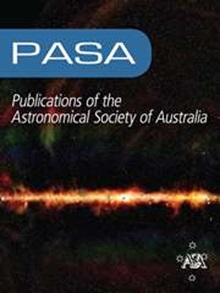VERTICO V: The environmentally driven evolution of the inner cold gas discs of Virgo cluster galaxies
IF 4.6
3区 物理与天体物理
Q1 ASTRONOMY & ASTROPHYSICS
Publications of the Astronomical Society of Australia
Pub Date : 2023-03-14
DOI:10.1017/pasa.2023.14
引用次数: 4
Abstract
Abstract The quenching of cluster satellite galaxies is inextricably linked to the suppression of their cold interstellar medium (ISM) by environmental mechanisms. While the removal of neutral atomic hydrogen (H i) at large radii is well studied, how the environment impacts the remaining gas in the centres of galaxies, which are dominated by molecular gas, is less clear. Using new observations from the Virgo Environment traced in CO survey (VERTICO) and archival H i data, we study the H i and molecular gas within the optical discs of Virgo cluster galaxies on 1.2-kpc scales with spatially resolved scaling relations between stellar ( $\Sigma_{\star}$ ), H i ( $\Sigma_{\text{H}\,{\small\text{I}}}$ ), and molecular gas ( $\Sigma_{\text{mol}}$ ) surface densities. Adopting H i deficiency as a measure of environmental impact, we find evidence that, in addition to removing the H i at large radii, the cluster processes also lower the average $\Sigma_{\text{H}\,{\small\text{I}}}$ of the remaining gas even in the central $1.2\,$ kpc. The impact on molecular gas is comparatively weaker than on the H i, and we show that the lower $\Sigma_{\text{mol}}$ gas is removed first. In the most H i-deficient galaxies, however, we find evidence that environmental processes reduce the typical $\Sigma_{\text{mol}}$ of the remaining gas by nearly a factor of 3. We find no evidence for environment-driven elevation of $\Sigma_{\text{H}\,{\small\text{I}}}$ or $\Sigma_{\text{mol}}$ in H i-deficient galaxies. Using the ratio of $\Sigma_{\text{mol}}$ -to- $\Sigma_{\text{H}\,{\small\text{I}}}$ in individual regions, we show that changes in the ISM physical conditions, estimated using the total gas surface density and midplane hydrostatic pressure, cannot explain the observed reduction in molecular gas content. Instead, we suggest that direct stripping of the molecular gas is required to explain our results.VERTICO V:室女座星系团内部冷气体盘的环境驱动演化
星系团卫星星系的猝灭与环境机制对其冷星际介质(ISM)的抑制密不可分。虽然中性原子氢(H i)在大半径范围内的去除已经得到了很好的研究,但环境如何影响以分子气体为主的星系中心的剩余气体,还不太清楚。利用在CO调查(VERTICO)中追踪的室女座环境的新观测数据和存档的H数据,我们在1.2 kpc尺度上研究了室女座星系团光盘内的H和分子气体,并研究了恒星($\Sigma_{\star}$), H ($\Sigma_{\text{H}\,{\small\text{i}}$)和分子气体($\Sigma_{\text{mol}}$)表面密度之间的空间分解比例关系。采用氢缺乏作为环境影响的衡量标准,我们发现证据表明,除了在大半径上去除氢之外,集群过程还降低了剩余气体的平均$ $ Sigma_{\text{H}},{\small\text{i}}}$,即使在中心$ $1.2\,$ kpc。对分子气体的影响相对弱于对H i的影响,我们发现较低的$\Sigma_{\text{mol}}$气体首先被去除。然而,在大多数缺乏氢的星系中,我们发现有证据表明,环境过程将剩余气体的典型Sigma_{\text{mol}}$减少了近3倍。我们没有发现环境驱动的$\Sigma_{\text{H}\、{\small\text{I}} $或$\Sigma_{\text{mol}}$的升高的证据。利用单个区域$\Sigma_{\text{mol}}$与- $\Sigma_{\text{H}\,{\small\text{I}} $的比值,我们表明,用总气体表面密度和中层静水压力估计的ISM物理条件的变化不能解释观察到的分子气体含量的减少。相反,我们认为需要直接剥离分子气体来解释我们的结果。
本文章由计算机程序翻译,如有差异,请以英文原文为准。
求助全文
约1分钟内获得全文
求助全文
来源期刊
CiteScore
5.90
自引率
9.50%
发文量
41
审稿时长
>12 weeks
期刊介绍:
Publications of the Astronomical Society of Australia (PASA) publishes new and significant research in astronomy and astrophysics. PASA covers a wide range of topics within astronomy, including multi-wavelength observations, theoretical modelling, computational astronomy and visualisation. PASA also maintains its heritage of publishing results on southern hemisphere astronomy and on astronomy with Australian facilities.
PASA publishes research papers, review papers and special series on topical issues, making use of expert international reviewers and an experienced Editorial Board. As an electronic-only journal, PASA publishes paper by paper, ensuring a rapid publication rate. There are no page charges. PASA''s Editorial Board approve a certain number of papers per year to be published Open Access without a publication fee.

 求助内容:
求助内容: 应助结果提醒方式:
应助结果提醒方式:


